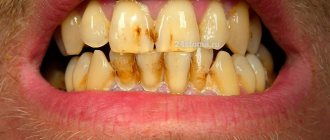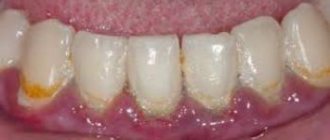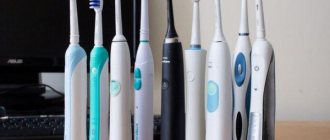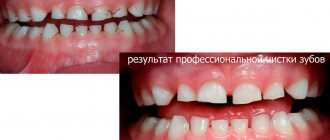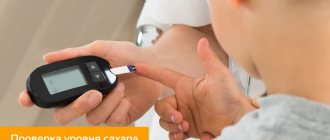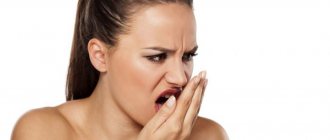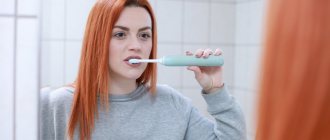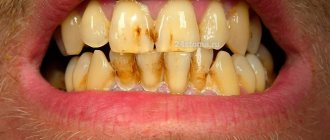In most cases, dental plaque is the cause of insufficient oral hygiene. But it also happens that people who are very sensitive to hygiene issues develop black plaque on their teeth.
The reasons for its appearance in adults and children differ : if in the former it is a consequence of drinking large amounts of tea and coffee, as well as smoking, then in the latter it may be associated with the activity of certain bacteria, the use of mouthwashes and the use of chewable vitamins.
Types of plaque
Plaque on teeth is divided into two large groups:
- the occurrence of which is associated with external contamination of the tooth;
- appearing due to the deposition of pigments.
If oral hygiene is not maintained, plaque may appear on the teeth:
- soft microbial;
- mineralized;
- hard, often called tartar.
If everything is in order with hygiene, then black plaque is a consequence of:
- regular consumption of tea, coffee and nicotine;
- use of medications with high iron content;
- vital activity of chromogenic bacteria;
- use of certain types of rinses and antiseptics.
What to do if the drug is accidentally swallowed?
During the procedure, it is necessary to avoid getting Chlorhexidine into the stomach, but if this happens, there is no need to panic. The need to take any measures depends on the amount of the drug that enters the stomach. If the volume does not exceed one sip, you can do nothing, but at the same time carefully monitor how you feel.
- What medicine is put into the hole after tooth extraction?
If pain or cramping occurs in the abdomen, it is necessary to rinse the stomach with warm soda or saline solution, and then take any sorbent drug, for example:
- "Neosmectin";
- "Smectu";
- "Filtrum-sti";
- Activated carbon;
- "Polysorb".
Activated carbon
The same steps must be performed if the amount of medicine swallowed is more than 10 ml. If you feel unwell, have intestinal or stomach cramps or signs of intoxication, you should consult a doctor.
"Chlorhexidine" is one of the most famous and affordable antiseptics used in dental practice. It allows for disinfection of the oral cavity after surgery and prevents pathogenic bacteria from entering the socket of the extracted tooth. If you use Chlorhexidine according to the regimen prescribed by your doctor, you can avoid serious complications, for example, purulent-infectious lesions of the periosteum or alveolitis. During use, it is important to follow the precautions described in the official instructions for the drug.
Bacterial plaque on teeth: causes
Soft or, as it is also called, bacterial plaque has a soft consistency, so it is easy to get rid of it with the help of an ordinary toothbrush. The main place of its accumulation is the neck of the teeth.
Harder plaque that cannot be removed with a brush is called tartar. It occurs during the mineralization of soft plaque with phosphorus and calcium salts present in saliva.
Why does plaque form?
There are constantly a huge number of bacteria in the mouth, which, firstly , multiply, and secondly , leave behind waste products. Even if you brush your teeth regularly, plaque cannot be avoided: within 6 hours after thorough brushing, you can easily notice, without resorting to the use of specialized equipment, a bacterial mass on the surface of the tooth enamel. A surge in microbial activity is observed immediately after eating: leftover food in the mouth forces bacteria to begin intensive processing.
At the same time, even small pieces of food that are invisible to the human eye are enough for microorganisms: they can feed on a film consisting of carbohydrates and proteins that invariably remains on the surface of the teeth after eating, and on food debris that gets into the spaces between the teeth. In this regard, it is imperative to brush your teeth for 15 minutes after each meal, since the mass of bacterial plaque can increase several times in volume in 1-2 hours. Plaque accumulates especially intensely on the necks of teeth in people who like to snack on a bun or something sweet between main meals.
Almost immediately after the soft plaque appears, the process of mineralization begins, as a result of which it gradually hardens. The period of primary mineralization (i.e., when the plaque, in simple terms, “sets” but still remains loose) is 10-15 hours. When the plaque finally hardens, its surface becomes ideal for the formation of deposits.
Pigmented dark plaque on teeth
The main reason for the appearance of such plaque in adults is smoking, drinking coffee and tea. Maintaining hygiene guarantees the absence of bacterial plaque and tartar, but if you neglect it, black plaque will not take long to appear. Pigments adhere very well to enamel covered with bacterial plaque formed as a result of infrequent brushing of teeth.
Types of pigment plaque include:
- brown coating that occurs from regular consumption of tea and coffee in large quantities;
- accumulation of nicotine deposits;
- darkening of the enamel as a result of taking medications containing iron;
- proliferation of bacteria that form dyes (they are called chromogenic);
- change in enamel color after using antibiotics;
- blackening due to diseases of internal organs.
If plaque is caused by bacterial factors, then regular thorough brushing of teeth, the use of rinses and floss reduce the likelihood of its occurrence to a minimum. However, if the reason for the appearance of plaque lies in the influence of dyes, maintaining hygiene to prevent it will not help.
Black plaque on children's teeth , the causes of which are associated with the activity of chromogenic anaerobic bacteria, appears in the form of spots localized in the neck area. Actinomycete bacteria produce hydrogen sulfite, which reacts with iron (found in saliva and red blood cells). As a result, a form of black iron that cannot be cleaned off with a regular brush is deposited on the surface of the teeth. Chromogenic coloration can also be orange, green and brown.
Black plaque on a child’s teeth can also form for other reasons . It appears due to:
- the use of antiseptics that contain chlorhexidine, benzaclonium chloride, as well as essential oils (the latter are found in the popular Listerine product);
- consumption of foods rich in iron, as well as vitamins with a high content of iron.
How to remove plaque from teeth on your own
Many people do not like to visit the dentist again, especially when it comes to removing plaque, which does not cause much inconvenience. The reasons for this are clear: lack of free time and reluctance to pay for the procedure.
You can try to remove plaque from your teeth at home, but this will only work if there are no subgingival deposits and the plaque layer is thin.
The first method involves using a special toothpaste to remove plaque with abrasive substances. The label of such pastes must indicate the RDA indicator, indicating the degree of abrasiveness. In pastes that eliminate plaque, its value should exceed 100. But such pastes cannot be used on an ongoing basis. If the paste contains pyrophosphates, then it can help get rid of tartar, since they have the ability to dissolve its matrix.
The most effective of these pastes are:
- President White Plus. The abrasiveness index is 200 units; in addition, the composition contains silicon dioxide, which has abrasive and polishing properties. You should not use the paste more than once a week.
- Lacalut White. According to the abrasiveness index (RDA=120), it is more gentle than the previous sample. The composition contains pyrophosphates, which make the plaque loose.
The second method is to use a special toothbrush, which allows you to remove plaque yourself. Recommended use:
Is it possible to rinse your mouth with Chlorhexidine?
Rinsing the mouth with this drug helps quickly eliminate inflammation and swelling, and has a regenerating effect on damaged tissue.
It is allowed to use Chlorhexidine for a number of diseases:
- Inflammation of the gums. Helps quickly eliminate unwanted symptoms and minimizes the risk of periodontal disease.
- Stomatitis. It is used for ulcerative and aphthous forms caused by the herpes virus.
- Throat diseases. Used to eliminate negative symptoms of pharyngitis, sore throat and laryngitis.
Chlorhexidine is used for stomatitis
In dentistry, it is recommended to use after tooth extraction, if there is a risk of wound infection, or for toothache. Chlorhexidine also prevents plaque on tooth enamel and eliminates bad breath.
The drug promotes the rapid elimination of biofilm at the site of the inflammatory process - this makes harmful microorganisms vulnerable to the action of the antibiotic.
Plaque on a child’s teeth: treatment
Removing bacterial and chromogenic plaque in a child will be no different from a similar procedure recommended for an adult: ultrasonic cleaning and AirFlow are used in the same way.
However, chromogenic staining of teeth may return over time. The only possible solution to the problem is regular professional cleaning by a dentist. To make visits to the dentist as rare as possible, your child should be taught to use an electric toothbrush, the pulsating circular movements of the head of which perfectly break up plaque.
Accelerated formation of deposits is promoted by blood in the oral cavity, so the child’s gingivitis must be treated. The use of chlorhexidine and antiseptics based on it should be abandoned.
Possible contraindications and side effects
"Chlorhexidine" has practically no contraindications, with the exception of various groups of dermatitis. The manufacturer warns about possible intolerance to the drug and allergic reactions to the components of the solution, but practice shows that allergies to the drug are very rare - less than 1% of patients.
Contraindications and side effects
Side effects during use are rare. Patients may experience increased dryness of the mucous membranes of the oral cavity, tingling, burning and itching. These phenomena are of moderate intensity and do not require discontinuation of the drug or cessation of treatment.
Important! Most patients tolerate Chlorhexidine well, but in very rare cases, adverse reactions may occur. Extremely rarely, intolerance can manifest itself as a pinpoint, pale pink rash on the surface of the tongue, gums and inner surface of the cheeks. If this symptom appears, you should consult a doctor.
"Chlorhexidine" is sold in all pharmacies
